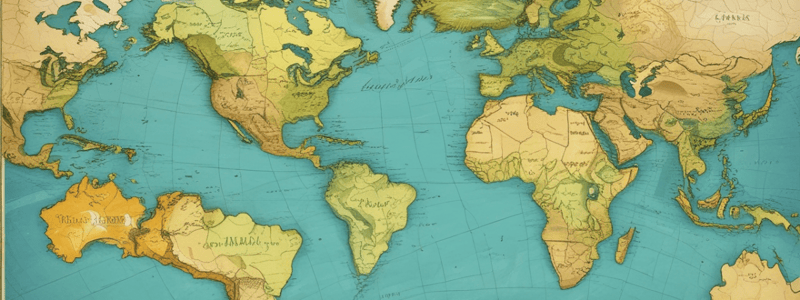Podcast
Questions and Answers
What type of location is described by mathematical coordinates on an Earth grid?
What type of location is described by mathematical coordinates on an Earth grid?
- Spatial Distribution
- Absolute Location (correct)
- Relative Location
- Spatial Pattern
What is the primary goal of the Spatial Science Perspective in physical geography?
What is the primary goal of the Spatial Science Perspective in physical geography?
- To study the spatial distribution of tropical rainforests
- To assess the process of spatial interaction
- To determine the differences and similarities between physical features (correct)
- To describe spatial patterns of earthquakes
What is spatial distribution in the context of physical geography?
What is spatial distribution in the context of physical geography?
- The study of spatial patterns of earthquakes
- The arrangement of multiple individuals of the same type
- The process of spatial interaction
- The extent of area or areas where a feature exists (correct)
What is spatial pattern in the context of physical geography?
What is spatial pattern in the context of physical geography?
What is the term for the process whereby different phenomena are linked or interconnected and impact one another through Earth space?
What is the term for the process whereby different phenomena are linked or interconnected and impact one another through Earth space?
What is the main difference between absolute location and relative location?
What is the main difference between absolute location and relative location?
What can be a consequence of excessive rainfall in Minnesota and Wisconsin?
What can be a consequence of excessive rainfall in Minnesota and Wisconsin?
What is the Environmental Science Perspective primarily concerned with?
What is the Environmental Science Perspective primarily concerned with?
What is the study of interactions between organisms and their environment called?
What is the study of interactions between organisms and their environment called?
What is an ecosystem?
What is an ecosystem?
What is a characteristic of ecosystems?
What is a characteristic of ecosystems?
What is considered in physical geography, in addition to natural environmental relationships?
What is considered in physical geography, in addition to natural environmental relationships?
What happens in a system when a positive feedback reaction occurs?
What happens in a system when a positive feedback reaction occurs?
What is the primary function of negative feedback in a system?
What is the primary function of negative feedback in a system?
What is the term for a set of feedback operations that can be repeated as a cycle?
What is the term for a set of feedback operations that can be repeated as a cycle?
What type of system is Earth considered to be?
What type of system is Earth considered to be?
What is the term for the point at which a system undergoes a significant change?
What is the term for the point at which a system undergoes a significant change?
What is the primary purpose of studying systems in physical geography?
What is the primary purpose of studying systems in physical geography?
What is the primary distinction between physical and human geography?
What is the primary distinction between physical and human geography?
Why is geography considered a spatial discipline?
Why is geography considered a spatial discipline?
What is a geographic region?
What is a geographic region?
How do modern technologies contribute to physical geography?
How do modern technologies contribute to physical geography?
What are the three major perspectives of physical geography?
What are the three major perspectives of physical geography?
Why is it important to consider Earth as a system?
Why is it important to consider Earth as a system?
What is the first step in studying a system?
What is the first step in studying a system?
What type of system is the Earth considered in terms of energy?
What type of system is the Earth considered in terms of energy?
What is the purpose of a systems model?
What is the purpose of a systems model?
What is an example of negative feedback?
What is an example of negative feedback?
What type of system is the Earth considered in terms of matter?
What type of system is the Earth considered in terms of matter?
What happens in a system when there is negative feedback?
What happens in a system when there is negative feedback?
What is the term for the solid part of the Earth system?
What is the term for the solid part of the Earth system?
Which component of the Earth system includes all living things?
Which component of the Earth system includes all living things?
What is the term for the Earth's waters?
What is the term for the Earth's waters?
What term describes the blanket of air that surrounds the Earth?
What term describes the blanket of air that surrounds the Earth?
What is the term for the Earth system that includes all solid, liquid, and gaseous components?
What is the term for the Earth system that includes all solid, liquid, and gaseous components?
Study Notes
The Earth's Systems
- The Earth's systems consist of the atmosphere (a blanket of air), lithosphere (solid rock part), biosphere (living things), and hydrosphere (waters of Earth).
Physical Geography
- Physical geography is a spatial discipline that studies the Earth's physical features, processes, and relationships between them.
- It involves the study of the Earth's systems and their interactions.
- Objectives of physical geography include describing the difference between physical and human geography, explaining why geography is a spatial discipline, and discussing the concept of a geographic region.
Major Perspectives in Physical Geography
- The three major perspectives are:
- Physical Science Perspective: studies the Earth's physical features and processes.
- Spatial Science Perspective: examines the spatial distribution and patterns of physical features, and how they interact with each other.
- Environmental Science Perspective: focuses on the natural environment, including weather, climate, landforms, rocks, soil, water, plants, and animals.
Spatial Science Perspective
- Characteristics of places: determines what physical features give a particular place its distinctive appearance.
- Spatial distribution: the extent of an area or areas where a feature exists.
- Spatial pattern: how multiple individuals of the same type are arranged over the Earth's surface.
- Spatial interaction: the process whereby different phenomena are linked or interconnected and impact each other through Earth space.
- Change over space and time: the Earth's features and landscapes change continually.
Environmental Science Perspective
- The environment is everything that surrounds us, including physical, social, and cultural aspects that affect our growth, health, and way of life.
- Ecosystems: communities of organisms functioning together through interdependent relationships with the environment.
- Ecosystems are dynamic, with their parts always changing.
Working with Models and Earth Systems
- Systems: boundaries that define the system and its component parts.
- Open systems: allow energy and materials to freely cross its boundaries.
- Closed systems: no substantial amount of materials can cross its boundaries.
- Earth is an open system for energy but virtually closed in terms of matter.
- Feedback: an adjustment in response to change, which can be negative (counteracts the initial change) or positive (reinforces the initial change).
- Feedback loops: a set of feedback operations that can be repeated as a cycle.
Studying That Suits You
Use AI to generate personalized quizzes and flashcards to suit your learning preferences.
Related Documents
Description
Test your understanding of the basics of physical geography, including the difference between physical and human geography, spatial disciplines, and geographic regions. Review key concepts and objectives from Chapter 1 of your Physical Geography course.




